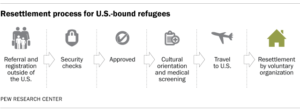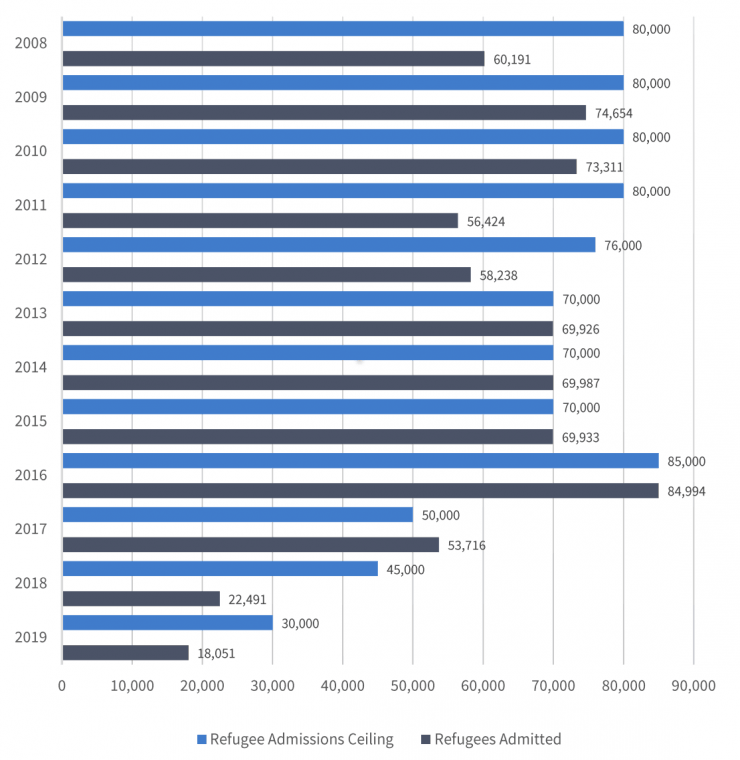“Trump administration nearly halves refugee cap for coming year”.
Politico
The United States plans to admit a maximum of 18,000 refugees in the upcoming fiscal year, down from a cap of 30,000 this year, under a new refugee admissions ceiling set by the Trump administration. According to the Pew Research Center: This would be the lowest number of refugees resettled by the U.S. in a single year since 1980 when Congress created the nation’s refugee resettlement program.
World Refugee Situation:
The number of forcibly displaced people around the world has skyrocketed since 2007, growing from 42.7 million that year to 68.5 million as of 2017. This significant surge in the number of refugees is due to armed conflicts in Syria, Myanmar, and the Democratic Republic of the Congo (DRC). However, people are also being displaced in large numbers by conflicts in Burundi, the Central African Republic, Iraq, South Sudan, Sudan, Ukraine, and Yemen. According to the United Nations High Commissioner for Refugees (UNHCR), there were 19.6 million refugees worldwide in 2017, up from 9.9 million in 2012. n 2017, children under the age of 18 represented just over half (52 percent) of the refugee population. The top-five origin countries for refugees in 2017 were Syria (6.3 million), Afghanistan (2.6 million), South Sudan (2.4 million), Myanmar (1.2 million), and Somalia (986,400).
How Does U.S. Law Define “Refuge”, and How Is It Related to USRAP?
Under U.S. law, a “refugee” is a person who is unable or unwilling to return to his or her home country because of a “well-founded fear of persecution” due to race, membership in a particular social group, political opinion, religion, or national origin. This definition is based on the United Nations 1951 conventions and 1967 protocols relating to the status of Refugees, which the United States joined in 1968. Congress passed the Refugee Act pf 1980, which incorporated the Convention’s definition into U.S. law and provides the legal basis for today’s U.S. Refugee Admissions Program (USRAP). The President, in consultation with Congress, determines the numerical ceiling for refugee admissions each year. The State Department and Department of Homeland Security (DHS) are the primary agencies involved in assessing the viability of different refugee populations for admission, as well as the capacity of U.S. government officials to process them. For Fiscal Year (FY) 2019, the ceiling was set at an all-time low of 30,000, down from the previous all-time low of 45,000 set in FY 2018 — although the number of refugees admitted in 2018 was only half of that number (22,415).
U.S. Refugee Resettlement process:
- Refugees who pass their security screening, and who fall within the numerical limits of a given year’s refugee admissions ceiling, become eligible for resettlement within the United States
- Individual eligibility for refugee status is determined through interviews conducted by officers in U.S. Citizenship and Immigration Services (USCIS), which is part of DHS
- Newly admitted refugees are resettled by and gain access to important services through, the Refugee Admissions Program (RAP)
There are also three principal categories through which individuals can seek access to the U.S. refugee program:
- Priority One. Individuals with compelling persecution needs or those for whom no other durable solution exists. These individuals are referred to the United States by UNHCR, or they are identified by a U.S. embassy or a non-governmental organization (NGO).
- Priority Two. Groups of “special concern” to the United States, which are selected by the Department of State with input from USCIS, UNHCR, and designated NGOs. Currently, the groups include certain persons from the former Soviet Union, Burma, and Iraq.
- Priority Three. The relatives (parents, spouses, or unmarried children under 21) of refugees who are already settled in the United States. The U.S.-based relative must file an Affidavit of Relationship (AOR) and must be processed by DHS.
Source: U.S. Department of State, Refugee Processing Center, May 31, 2019.
The fiscal Year 2019 as of May 31, 2019.
However, the application of “Refugee” status does not guarantee entry to the United States, and there are additional steps involved:
- Before admission to the United States, each refugee must undergo a rigorous interviewing process to ensure that the individual meets the “refugee” definition.
- United States law requires prospective refugees to prove their individual case of “well-founded fear,” regardless of the person’s country, circumstance, or classification in a priority category.
- Individuals generally must not already have “firmly resettled” in any other country.
The Regional Refugee Coordinators and overseas Resettlement Support Centers (RSCs) conduct extensive screening and a security clearance process. Also, applications for refugee resettlement can be denied on:
- health-related grounds
- criminal grounds
- security grounds.
- Polygamy
- misrepresentation of facts on visa applications
- Smuggling
- previous deportations.
In January 2018, DHS introduced “additional security enhancements and recommendations to strengthen the integrity of the U.S. Refugee Admissions Program,” which include additional screening of individuals from “high risk” countries, administering the program in a more “risk-based” manner, and a periodic review of countries deemed to be “high risk.” However, waivers can be granted in some cases.
Change in the Resettlement Process after 2017 to Present:
The prospects for refugees hoping to resettle in the United States changed abruptly in 2017. In January of that year, President Trump signed an executive order that suspended the entire U.S. refugee admissions program for 120 days. In addition, the Trump administration suspended indefinitely the entry of Syrian refugees into the country and lowered the FY 2017 refugee admissions ceiling from 110,000 (set under the Obama administration) to 50,000. The admissions ceiling was lowered to 45,000 in 2018 (with fewer than 50 percent admitted) and again to 30,000 in 2019. More details about Refugee Admissions and Resettlement Policy can be found here
A Comparative Analysis of Refugee Settlement Based on Population:
By the end of Calendar Year (CY) 2017, the U.S. government had resettled about 33,000 refugees, while other nations collectively resettled a total of 69,000. When the population size of the nations in which refugees are resettled is taken into account, Canada was the resettlement leader in CY 2017 at 725 refugees resettled per one million residents, followed by Australia (618), and Norway (528). In comparison, the United States resettled 102 refugees per one million U.S. residents. According to Pew Research Center: Canada resettled 28,000 refugees last year, similar to its total in 2017. Meanwhile, the U.S. resettled 23,000, down from 33,000 the previous year – and a recent high of 97,000 in 2016. Several other leading countries for refugee resettlement, including Australia and the United Kingdom, also saw declines last year.



